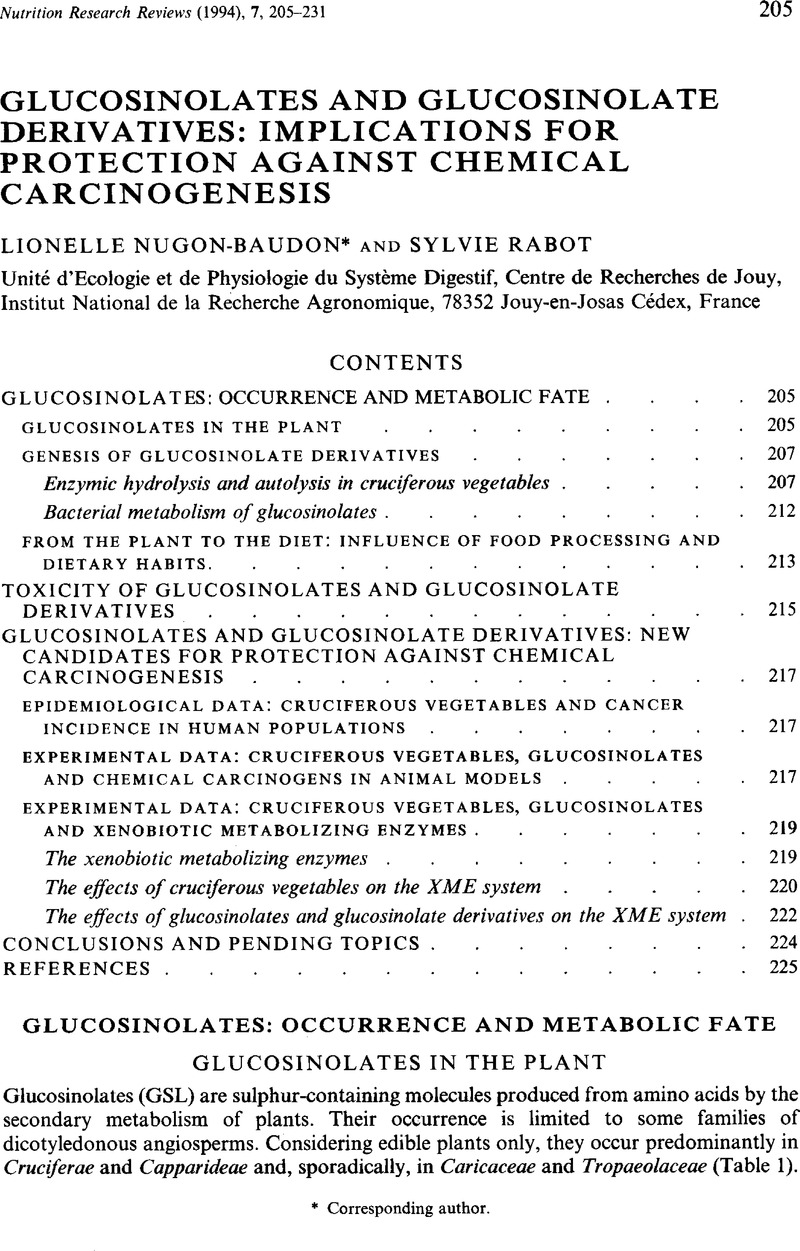Crossref Citations
This article has been cited by the following publications. This list is generated based on data provided by Crossref.
Roland, N.
Rabot, S.
and
Nugon-Baudon, L.
1996.
Modulation of the biological effects of glucosinolates by inulin and oat fibre in gnotobiotic rats inoculated with a human whole faecal flora.
Food and Chemical Toxicology,
Vol. 34,
Issue. 8,
p.
671.
Hashim, S
Banerjee, S
Madhubala, R
and
Rao, A.R
1998.
Chemoprevention of DMBA-induced transplacental and translactational carcinogenesis in mice by oil from mustard seeds (Brassica spp.).
Cancer Letters,
Vol. 134,
Issue. 2,
p.
217.
Nugon-Baudon, L.
Rabot, S.
Flinois, J.-P.
Lory, S.
and
Beaune, Ph.
1998.
Effects of the bacterial status of rats on the changes in some liver cytochrome P450 (EC1.14.14.1) apoproteins consequent to a glucosinolate-rich diet.
British Journal of Nutrition,
Vol. 80,
Issue. 3,
p.
231.
Elfoul, L.
Rabot, S.
Duncan, A.J.
Goddyn, L.
Khelifa, N.
and
Rimbault, A.
1999.
Agri-Food Quality II.
p.
294.
Ciska, Ewa
Martyniak-Przybyszewska, Barbara
and
Kozlowska, Halina
2000.
Content of Glucosinolates in Cruciferous Vegetables Grown at the Same Site for Two Years under Different Climatic Conditions.
Journal of Agricultural and Food Chemistry,
Vol. 48,
Issue. 7,
p.
2862.
Burel, Christine
Boujard, Thierry
Escaffre, Anne-Marie
Kaushik, Sadasivam J.
Boeuf, Gilles
Mol, Koen A.
Van der Geyten, Serge
and
Kühn, Eduard R.
2000.
Dietary low-glucosinolate rapeseed meal affects thyroid status and nutrient utilization in rainbow trout (Oncorhynchus mykiss).
British Journal of Nutrition,
Vol. 83,
Issue. 6,
p.
653.
Tripathi, M.K
Agrawal, I.S
Sharma, S.D
and
Mishra, D.P
2001.
Effect of untreated, HCl treated or copper and iodine supplemented high glucosinolate mustard (Brassica juncea) meal on nutrient utilization, liver enzymes, thyroid hormones and growth of calves.
Animal Feed Science and Technology,
Vol. 92,
Issue. 1-2,
p.
73.
Fowke, Jay H
Fahey, Jed W
Stephenson, Katherine K
and
Hebert, James R
2001.
Using isothiocyanate excretion as a biological marker of Brassica vegetable consumption in epidemiological studies: evaluating the sources of variability.
Public Health Nutrition,
Vol. 4,
Issue. 3,
p.
837.
Krul, Cyrille
Humblot, Christèle
Philippe, Catherine
Vermeulen, Martijn
van Nuenen, Marleen
Havenaar, Robert
and
Rabot, Sylvie
2002.
Metabolism of sinigrin (2-propenyl glucosinolate) by the human colonic microflora in a dynamic in vitro large-intestinal model.
Carcinogenesis,
Vol. 23,
Issue. 6,
p.
1009.
Fowke, Jay H
Hebert, James R
and
Fahey, Jed W
2002.
Urinary excretion of dithiocarbamates and self-reported Cruciferous vegetable intake: application of the ‘method of triads’ to a food-specific biomarker.
Public Health Nutrition,
Vol. 5,
Issue. 6,
p.
791.
McNaughton, S. A.
and
Marks, G. C.
2003.
Development of a food composition database for the estimation of dietary intakes of glucosinolates, the biologically active constituents of cruciferous vegetables.
British Journal of Nutrition,
Vol. 90,
Issue. 3,
p.
687.
Lhoste, E.F.
Gloux, K.
De Waziers, I.
Garrido, S.
Lory, S.
Philippe, C.
Rabot, S.
and
Knasmüller, S.
2004.
The activities of several detoxication enzymes are differentially induced by juices of garden cress, water cress and mustard in human HepG2 cells.
Chemico-Biological Interactions,
Vol. 150,
Issue. 3,
p.
211.
Huyskens-Keil, Srsanne
and
Schreiner, Monika
2004.
Production Practices and Quality Assessment of Food Crops.
p.
401.
Ciska, Ewa
and
Pathak, Dorothy R.
2004.
Glucosinolate Derivatives in Stored Fermented Cabbage.
Journal of Agricultural and Food Chemistry,
Vol. 52,
Issue. 26,
p.
7938.
Bender, David A
2005.
Naturally safe?.
Journal of the Science of Food and Agriculture,
Vol. 85,
Issue. 15,
p.
2511.
Fowke, Jay
2006.
Nutrient-Gene Interactions in Cancer.
p.
237.
Fuller, Zoë
Louis, Petra
Mihajlovski, Agnès
Rungapamestry, Vanessa
Ratcliffe, Brian
and
Duncan, Alan J.
2007.
Influence of cabbage processing methods and prebiotic manipulationof colonic microflora on glucosinolate breakdown in man.
British Journal of Nutrition,
Vol. 98,
Issue. 2,
p.
364.
Ciska, Ewa
Honke, Joanna
and
Kozłowska, Halina
2008.
Effect of Light Conditions on the Contents of Glucosinolates in Germinating Seeds of White Mustard, Red Radish, White Radish, and Rapeseed.
Journal of Agricultural and Food Chemistry,
Vol. 56,
Issue. 19,
p.
9087.
Kusznierewicz, Barbara
Bartoszek, Agnieszka
Wolska, Lidia
Drzewiecki, Jerzy
Gorinstein, Shela
and
Namieśnik, Jacek
2008.
Partial characterization of white cabbages (Brassica oleracea var. capitata f. alba) from different regions by glucosinolates, bioactive compounds, total antioxidant activities and proteins.
LWT - Food Science and Technology,
Vol. 41,
Issue. 1,
p.
1.
D'Antuono, L Filippo
Elementi, Simona
and
Neri, Roberta
2009.
Exploring new potential health‐promoting vegetables: glucosinolates and sensory attributes of rocket salads and related Diplotaxis and Eruca species.
Journal of the Science of Food and Agriculture,
Vol. 89,
Issue. 4,
p.
713.



